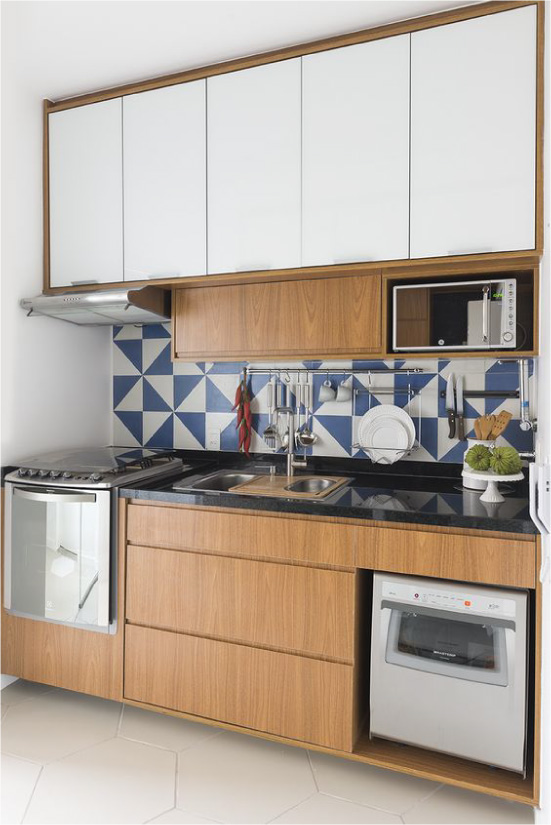Rails for the kitchen - this is a practical solution for storing any things - from ladles to glasses. Even the simplest hook bar can solve many problems:
- Make room on the tabletop so that you can knead the dough comfortably, cut and cook foods.
- Literally from nowhere to find additional storage space, free up space in the lockers. This is especially necessary in small kitchens - here the rails work wonders.
- Always have on hand the essentials (for example, spices, spatula, ladle, scissors, etc.).

The difficulty in planning a railing system for the kitchen is to choose the right hanging accessories, squeeze the maximum benefit out of wall storage, but at the same time not create a feeling of confusion and clutter.
- By the way, visual confusion is often a side effect of rails. However, a properly designed wall organizer can not only not spoil, but also embellish the interior in both classic and modern style.
In this article, you will learn how to choose rails for the kitchen, what accessories you can add, how, where and at what height to hang. Also here you will find 50 photo examples of wall rails in the kitchen interior.
What are the roof rails and hanging accessories
The rail system includes the following basic elements:
- Themselves rails - most often in the form of a pipe with a diameter of 16 mm or in the form of a flat strip. The length of one rod / bar can be 40, 60 (see the photo below), 80, 100, 120 cm or 3 m.

- Wall holders - most often they are sold with a barbell, their number depends on the length of the rail. Holders can be standard or end (for fastening the crossbar between two walls).
- Stubs - installed on the ends of the rails, so that they look beautiful and are closed on both sides.
- Corner Adapters (if required) - are used to combine two adjacent rails, while at the joints they are inserted into the coupling, then the joints are closed by the holders. Of course, connecting adjacent rods is not at all necessary, they can simply be closed with plugs.
- Coupling (if necessary) - is inserted into the openings of two pipes, then they are joined under pressure. In place of the junction always put the holder.
In addition to the basic elements necessarily need hanging accessories - they must be selected on the basis of individual needs.
- S-hooks - they can be large or small, as well as double. They can hang not only ladles and oven mitts, but also any utensils, dishes, cutting boards, and graters.
- Mini Shelves - you can put anything on them, for example, cans with bulk products, sauces, oil, etc.The shelves are small and large, regular and angular, single or double decker, with or without additional holders.
- Baskets and glasses - designed to store instruments, rims, blades and even for growing plants like greens.
- Drainer.

- Dryer for appliances.
- Towel holder - for example, it may have a crossbar and several hooks.
- The holder for paper towels.
- Holder for covers of pots and pans.
- Knife holder.
- The holder for boards.
- The holder for the tablet or the cookbook.
- Stand for hot.
- Spice rack - as a rule, it is narrow, it can be two-level. Often, the shelf can be purchased and "native" banks for spices.
- Shelf for wine glasses.
- Shelf for bottles.
- The holder for mugs and glasses.
- Breadbasket.
- The holder for rolls: towels, foil, film, baking paper.

Rail system in a small kitchen
All these elements can be combined in one design, for example, a bottle holder with a holder for glasses or, say, a holder for boards with a knife organizer.
How to choose and create your own railing system?
How can you make the combination you need from the whole variety of accessories? Here are some simple tips:
Tip 1. In most cases, 1-3 small rails is enough. In the kitchen area of 12 square meters. it is better not to use more than three meters of 60-centimeter roof rails, in order not to overload the space and not complicate the cleaning of the room. In most cases, even one or two rails can fit everything you need.

Tip 2. Choose hanging accessories based on your daily needs.
In order not to litter the space and not complicate the cleaning, store only the essentials on the wall.
- For example, it makes no sense to hang on the rails the entire stock of kitchen utensils and mugs - because if you do not use them every day, they will be covered with dust and at the right time you will have to spend time to rinse utensils. Yes, and hang the washed appliances on the hooks is not too convenient.
The universal principle of drawing up a rail system for an average kitchen: store on the wall only those items that you used to keep on the countertop and, possibly, in the closest to the work area drawers and cabinets.

For example, you can hang on rails:
- Holder for paper and kitchen towels.
- A shelf for spices, jars of salt, sugar, tea.
- Colander.
- Chopping board.
- Minimum set of devices: spatula, ladle, spoon, etc.
- Tack.
- Dryer for dishes.
- Shelf for dishwashing liquid, sponges and brushes.
- Scissors.
- Magnetic knife holder.
Adapt this list to your individual needs. Watch TV shows every day while cooking? Buy for your railing holder for the tablet.

Maybe your family especially likes coffee? Hang over coffee machine mini-railing with a set of mugs, a shelf for capsules, filters and additives as shown in the following photo.

Or maybe you have a mini-garden with greens or indoor plants? Suspended pots will look great on the wall.


Tip 3. Rails should fit the kitchen in style and color.
Contrary to common misconceptions, the rail system can be harmoniously entered into any interior - even in a palace or ultra minimalistic. The main thing - to choose the right rails, accessories and wall accessories for the design and color of the finish.
- The metal color of railings and accessories can be matched to the tone of furniture fittings, plumbing, household appliances, for example, hoods.

- For classic ceremonial as well as "village" kitchens (for example, country style or provence) bars of matte or antique gold, copper, brass, bronze, matte silver, as well as rails for forging will do. Brilliant, and especially chrome models for traditional cuisine will not work. Holders should be curly and elegant.
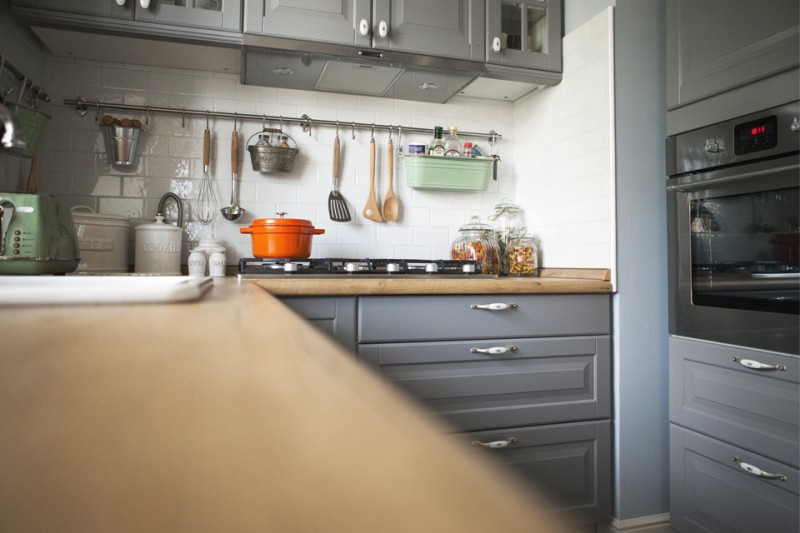
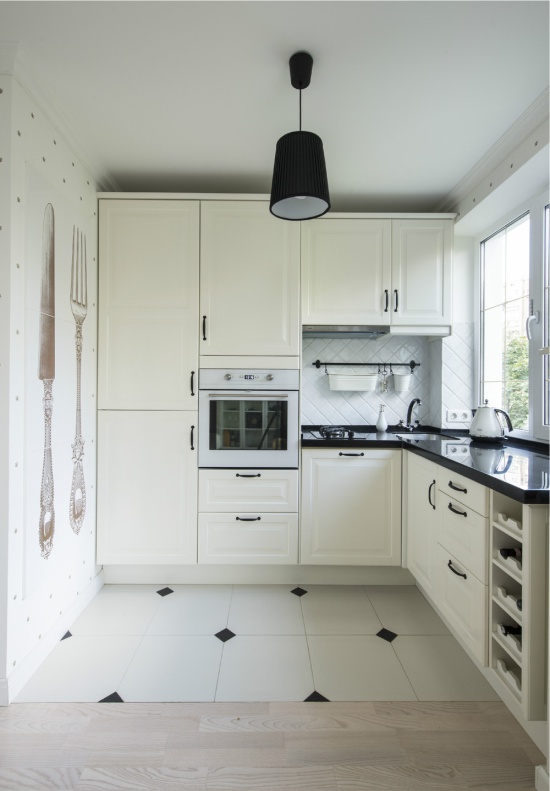
The interior of the traditional cuisine with black Ikea rails

Rails in the interior of a classic kitchen
- For a modern kitchen, let's say Scandinavian style, in high-tech style or minimalism any metal (including chrome-plated) rails of strict forms and without decorations will suit.

Instead of round pipes, you can choose flat bars. By the way, Ikea roof rails are supplemented with bamboo accessories - this is the perfect combination for modern kitchens (Rimfors series).
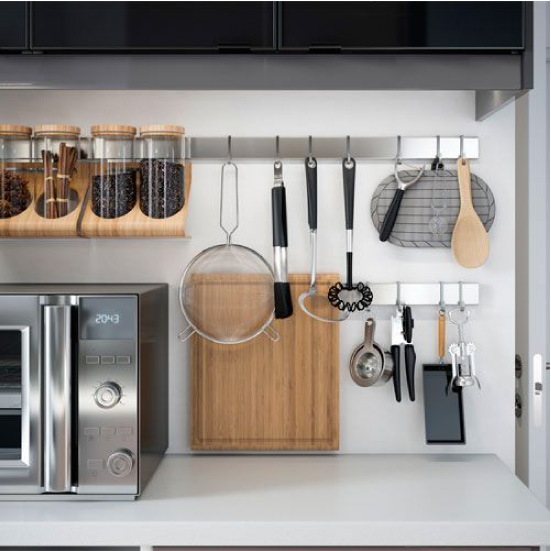
For loft style kitchens or industrial black or bronze rails are suitable as in the following photo.

Bronze rails
Tip 4. Use rails-shelves. To maximize the use of a limited area on the wall, use shelves instead of railing as in the photo below.

See also the material: Storage in the kitchen - 17 super-efficient solutions and life hacking
Some more lifehacks
- If there is not much space in the kitchen, you should not spend money on a separate holder for covers, because they can be conveniently stored as shown in the photo below.

- To save space on the kitchen railing, appliances and kitchen utensils can not be hung on the hooks separately from each other, but folded in one hanging glass.
- Keep kitchenware, food, dishes and textiles on the rails strictly by category. We often forget this simple and obvious rule, and meanwhile, its observance guarantees you order in the kitchen. For example, paper towels are more convenient to place next to kitchen towels and oven mitts, because they perform approximately the same function.
- If you pick up appliances, dishes, potholders and other "wall" things in the same color scheme, you can avoid the feeling of confusion and variegation. This advice is more relevant for those who equip their kitchen from scratch. Here are some photo examples of such wall storage.

Where to hang rails
Here are a few obvious and non-obvious places in the kitchen where you can install a rail system.
- Above the table top (in the cutting area). Here you need to keep all the most necessary while cooking: ladles, shovels, paper towels, etc.

- At the ends of the furniture.



- Under the hood (above the stove). It is convenient to hang up the railing for pans, appliances or spices.


If desired, a shelf for a cookbook can be installed above the hob. However, rather for the entourage - it is unlikely the book will withstand the constant effects of hot steam and splashes of fat.

- Over the sink. It is an ideal place for dryers and shelves for cleaning products, rags and sponges.
- In a niche or ledge.

- Near the coffee machine or electric kettle. Here, using the railing system, you can equip your home-made coffee bar.
- On the free walls next to the headset. Here you can place multiple rails.

- At the door.

- Above the bar counter - A great place for a shelf with glasses and a bottle.
- Under the shelves.
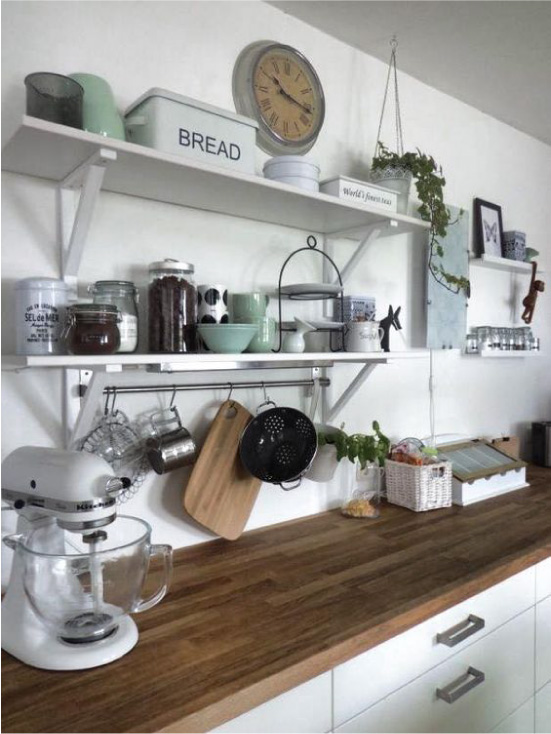

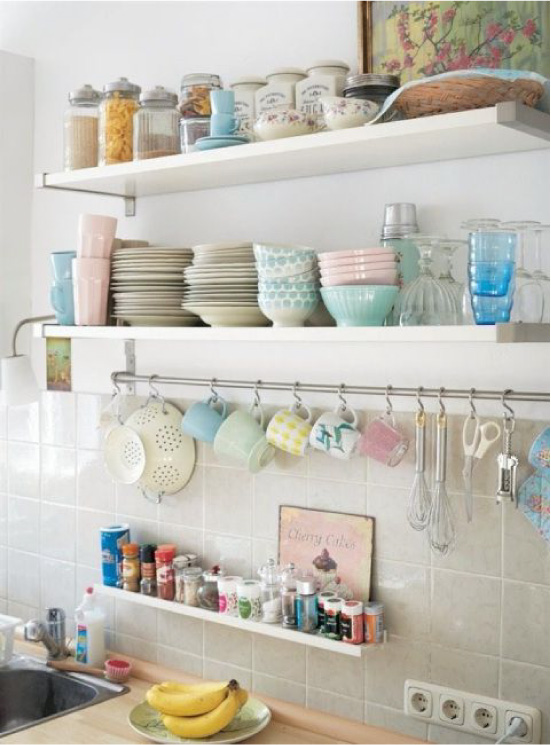
Where to buy a roofing system for the kitchen
- Excellent and well-designed rail systems can be bought in Ikea.
- Bronze and chrome rails are sold in Leroy Merlin.
- The most high-quality and expensive rails, made in Germany, are sold in specialized stores, where you can also buy Polish and Chinese accessories of average price and quality.
At what height hang rails in the kitchen
Standard height is 40-50 cm above the countertop level and not less than 5-10 cm from the wall cabinets. It is also convenient to place rails with shelves at eye level. The minimum allowable installation height of rails for the kitchen is 90 cm from the floor. The maximum is 170-180 cm.

However, strict rules on how high to hang rails, does not exist. It all depends on the intended composition, your height and personal preferences.
When choosing the height and location of installation, the main thing is to observe the principle of symmetry.
How to hang rails in the kitchen
Standard way:
- Having defined the height and installation site, make the markup using the building level.
- Drill a hole in the wall for standard dowels with a diameter of 6-8 mm.
- Insert the dowels into the holes, then screw in the screws with a semicircular head as far as they will go. Finally, hang the holders on the grommets.
- Assemble the railing design, including holders, if necessary, couplings, hooks and hanging accessories in the correct order.
- Hang the railing on the wall.
- Finally screw the holder to the rail.
- Screw plugs to the boom.
It is very important to establish the correct number of holders. For a bar 1 meter long, two holders are enough. If the length of the railing is more, you need to add holders based on the calculation: 1 holder for every 50 cm.
Finally, we offer to see a visual video instruction how to hang a railing in the kitchen.
More photos in the gallery:
- How to make a shelf with your own hands - 4 cool ways for beginners
- Assembling a kitchen set with your own hands as a designer
- 3 easy ways to upgrade your kitchen
- Features self-assembly kitchen corner set
- Guide to the selection and planning of kitchen furniture
- Handicrafts for home and kitchen do it yourself


